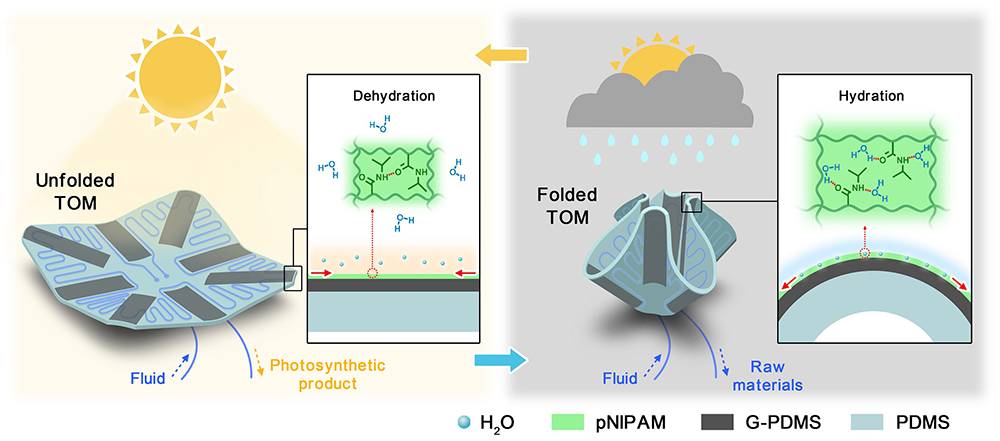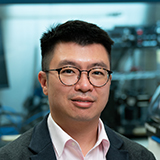November 2022 | Volume 24 No. 1
In the Clover
The leaves of plants can spread under sunlight and fold in the cold. What if man-made materials could achieve the same response to environmental stimuli?
A team from HKU’s Department of Mechanical Engineering has tested that question by mimicking the ability of the clover plant to bend and fold. Their work is in microfluidics, which involves manipulating and processing tiny amounts of liquid that potentially could be developed for uses such as drug delivery, tissue engineering and environmental applications.
The microfluidic device they developed has pre-set folds, like an origami sheet, that can respond to external stimulation. Called TransfOrigami microfluidics (TOM) to emphasise the connection between transformation and the origami structure, the device has broken new ground in materials development and was featured on the cover of Science Advances journal.
“Traditionally, these chips have been made of elastomeric polymers like rubber, with small channels etched in to manipulate the flow of fluids into and through the channels so they can form, for example, very controlled droplets. But these materials are inert and non-responsive and they have a passive role in regards to the channels,” said Professor Anderson Ho Cheung Shum of the Department of Mechanical Engineering, who supervised the project.
“If you look at similar channels in nature, such as the microvasculature in leaves, they can change position in relation to light, humidity, temperature etc. Even in our bodies, materials are very active.
“So we asked, can we make a synthetic microfluidic device with liquid flowing through it, that could be similarly active like in a natural biological system?”

Schematic drawing of the TransfOrigami microfluidics in its unfolded state when the temperature is high and light irradiates; folded state when the temperature is low and humidity is high. The insets show the schematic dehydration and hydration in the pNIPAM hydrogel layer of the actuating unit in the unfolded and folded states.
Turn to the light
Their device bends by contracting or relaxing in response to environmental stimuli. Dr Yi Pan, who led the team, explained how the device could respond to light.
“When the external environment is suitable for photosynthesis, for example on a sunny day, the device unfolds to promote photosynthesis. When the external environment is not conducive to photosynthesis, such as on a rainy day, it folds to slow down the photosynthesis,” he said.
That responsiveness and movement could also make the chip worth exploring for other dynamic, flexible uses, such as artificial vascular networks and shape-adaptive flexible electronics.
“For example, the surface of the human body is mostly curved. If flexible electronics can deform in response to stimulus, that may help the device transform better into the shape of the human body surface to improve the device’s performance,” Professor Shum said.
“Previously, we could only think about how to design the channels of microfluidic devices. Now, this ability to affect performance by modifying the properties of the material used opens up a new parameter, a whole new space for us to explore. We can make things more dynamic. This is a fantastic illustration of how humans can follow nature’s inspiration to facilitate technological design.”
Adding to the repertoire
The changes induced may also indirectly cause a response in the chemistry inside the channel where the liquid is contained – the potential results and applications of which can now be investigated.
The TOM is part of ongoing work by Professor Shum’s laboratory to explore the miniaturisation of the structures of droplets and jet-based platforms to improve or enhance their use in disease diagnostics and environmental monitoring and try to mimic biology.
Professor Shum, who recently was named President of the Hong Kong Young Academy of Sciences, has also been developing applications for his other research. For instance, he leads a major InnoHK laboratory, the Advanced Biomedical Instrumentation Centre, that has received several hundred million Hong Kong dollars to develop such things as affordable screening tests, personalised diagnostics, therapy approaches for new treatments, and advanced medical device components.
“I try to maintain a continuous flow of ideas in my group. Some of the more upstream things, like the TOM, we can work on at HKU and they give us a source of new innovations or ideas that we can apply in future. The TOM adds to the repertoire of tools we can use in future,” he said.
Previously, we could only think about how to design the channels of microfluidic devices. Now, this ability to affect performance by modifying the properties of the material used opens up a new parameter.

PROFESSOR ANDERSON HO CHEUNG SHUM

